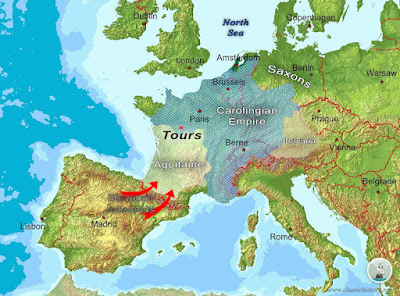In the Life of Charlemagne written by Einhard, and a few other Latin/Frankish sources, we find references to the Carolingians reaching out to the Abbasids. The Franks had clashed with the predecessors of the Abbasids, the Umayyad Caliphate, most notably at the Battle of Tours in 732. The Umayyads were finally expelled from Gaul by Pepin the Short.
After the collapse of the Umayyads and the rise of the Abbasids, Pepin reached out to Caliph al-Mansur. The Carolingians were powerful enough in Western Europe at that time that the Abbasids were open to the possibilities of an alliance; Umayyads still existed on the Iberian Peninsula, posing a potential threat to the southern border of the Carolingians and the western border of the Abbasids.
A Carolingian embassy visited Baghdad in 765 and returned with gifts after three years, followed by an Abbasid embassy to France in 768. Arabic coins from that era are found throughout the Carolingian world, and Arabic gold was exchanged for materials like timber and iron; also, slaves went eastward.
The alliance included a request from the Abbasids in 777 for military aid against the Umayyads in Cordoba. Charlemagne crossed the Pyrenees into Iberia in 778 with a large force, joining in Zaragoza with the Abbasid forces of Sulaymaniyah al-Arabi in an attempt to reconquer the peninsula. This was unsuccessful, and on Charlemagne's return to the north he was ambushed disastrously by Basques at Roncevaux.
Charlemagne did not give up on an alliance, however, and had a strong relationship with Harun al-Rashid, who gifted Charlemagne an elephant, recorded in the Royal Frankish Annals as Abul-Abbas. A few embassies went back and forth between the courts of Charlemagne and al-Rashid. (The illustration is of al-Rashid receiving a Frankish embassy.)
A few centuries later, France saw value in another alliance to the east, with the Mongol Empire. The reason and the result will be tomorrow's topic.













